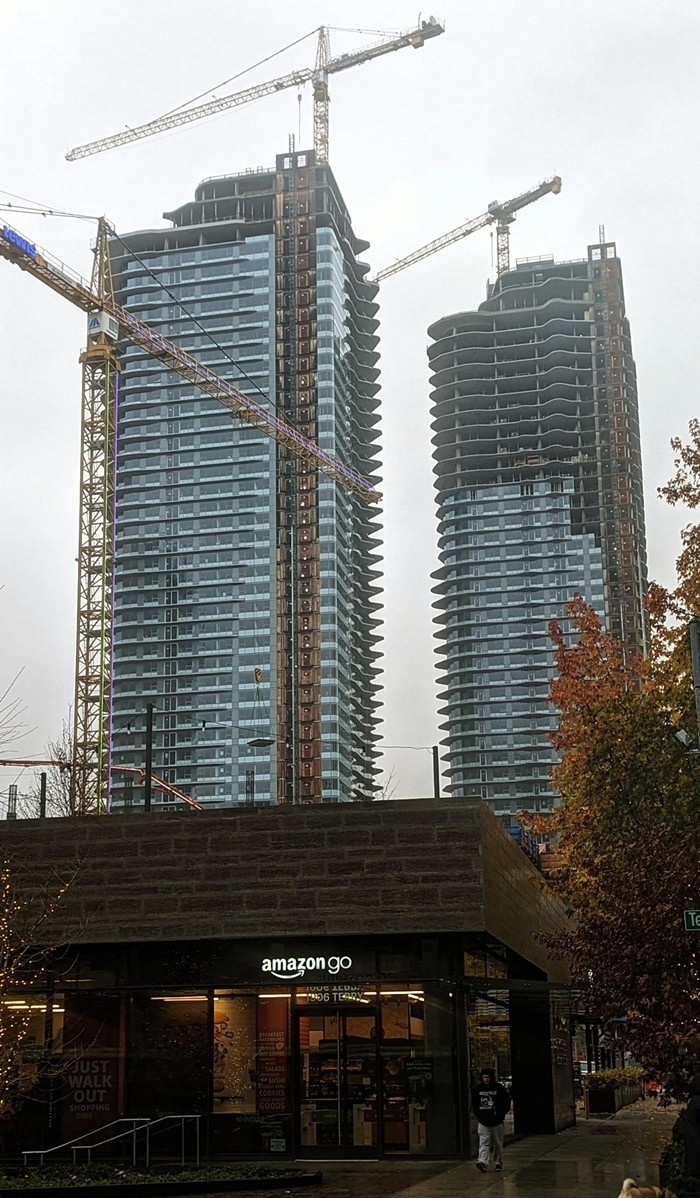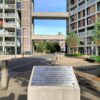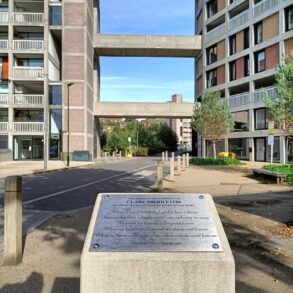I have written about the unfinished towers in the Denny Triangle in the past. Their future is, according to most reports, still unknown. Construction still appears slow, if it’s moving at all; images I took of the development in August of 2022 cannot be distinguished from those I took last week. According to Canada’s Globe and Mail, Westbank, the Vancouver, BC-based developer, has faced an “onslaught of litigation… due to unpaid bills.” That’s about as much as we know—or as much as we are allowed to know.
But what we can see, day in and day out, are the cranes sitting on top of the unfinished towers like stuffed birds. What might breathe life into them again? And how long can the city wait for construction to resume? This question brings me to Oceanwide Plaza in Los Angeles, an unfinished billion-dollar project that died in 2019 and is now known by the whole world as the Graffiti Towers.

A recent NBC headline about the buildings reads, “L.A.’s newest tourist attraction?” But why is this even a question? Of course two tall, unfinished towers covered in graffiti attracts spectators. But of course you just can’t say that straight in the headline. It hurts to admit that this massive, bold, glorious act “vandalism” has real cultural value.
NBC continues:
Crowds surrounded the popular Kobe Bryant statue outside Crypto.com Arena on Wednesday, and dozens of concertgoers lined up early for a rock show inside.
But the real draw for many near the intersection of 11th and Figueroa streets was the colorful graffiti decorating 30 floors of an abandoned real estate project.
@flyingssaucy Los Angeles newest attraction 🏙️ #losangeles #dtla #graffiti #drone #drones #dronevideo #viral #fyp #explore #travel #california ♬ original sound – The Dope Academy
Graffiti Towers are, in fact, the biggest cultural event to happen in downtown Los Angeles since the American Marxist theorist Fredric Jameson placed John Portman’s Bonaventure Hotel at the center of his 1984 masterpiece, Postmodernism, or The Cultural Logic of Late Capitalism. They capture what can only described as the urban sublime; not as the billionaire urbanism that the Beijing-based developer Oceanwide had intended to showcase before the company went bust in 2023, but as the streets, as the people, as popular art, as the freedom of living labor rather than the oppression of dead labor.
The scale of Oceanwide Plaza’s capital collapse is such that the city of Los Angeles, a city with a GDP of $1.5 trillion (which is on par with Brazil), is now stuck with buildings it can’t afford to demolish. The city council gave the developer a hard deadline of Saturday, Feb 17 to secure the site and clean up the graffiti, but Oceanwide, which has been liquidating since September 2023 due to unhappy money on Bermuda, the island where taxes are sent to mysteriously disappear, just didn’t respond. It was like the company didn’t even bother to pick up the phone, no matter how many times LA called. Or, maybe it would pick up the phone only to hang up immediately. That’s how Oceanwide seems to roll after the burst of China’s real estate bubble began in 2020.
So, what’s left? The city must dig into the public’s purse to pay the nearly $4 million tab to secure the dead buildings and remove what made them alive for the first time in five years. There was even the noble idea of repurposing the buildings into public housing. After all, Skid Row, where 6,000 homeless people live, is not far from the capital collapse. But an investment like that would just not do because, as the Financial Times made clear, it’s right next to King James’s palace for the rich and famous:
No one wants to have the largest public housing project in the state of California next to the Crypto.com Arena, where the Lakers, LA Clippers and Los Angeles Kings ice hockey club play, [soberly said Richard Schave, an LA historian].
But there is another reason why the buildings can’t be repurposed from billionaire urbanism to what LA and Seattle and other cities lack, the social spirit. The damage caused by incompletion and inactivity (a finished building is, after all, about constant maintenance) is so considerable it would “take up to a year of repairs just to get to the point where construction could resume.” And that year would cost a pretty penny.
Of course, the seemingly dead or dying or fighting-to-live or what-the-hell? buildings in the Denny Triangle, called WB1200, are by no means in the same situation as Oceanwide Plaza. As the Vancouver-based reporter Kerry G wrote in The Globe and Mail last week, Westbank is actually still alive and even has big plans to “build three [controversial] residential towers along Vancouver’s Broadway corridor near Commercial Drive.” Since such big companies with such big plans never go bust, it seems unlikely that Seattle’s city council will ever find itself in the same situation that LA is in today.
This post was originally published on this site be sure to check out more of their content.









